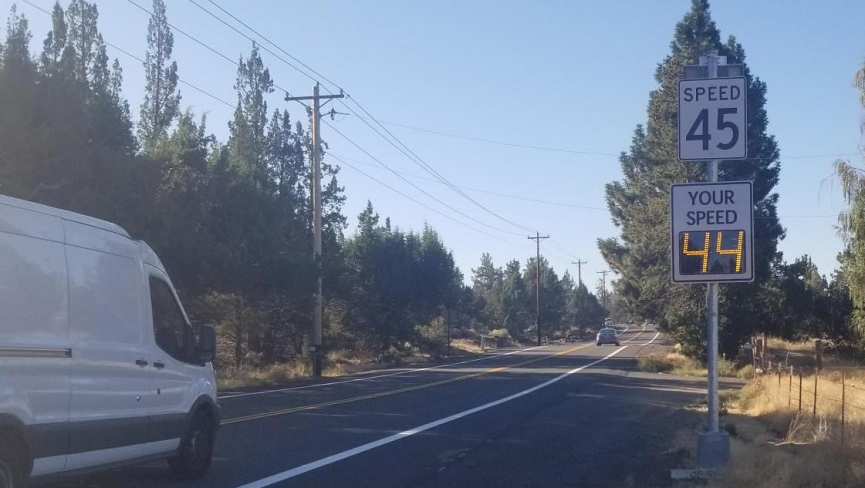Speed Limits

Concerns regarding speeding vehicles and speed enforcement on County roads should be reported to the Deschutes County Sheriff’s Office via the non-emergency dispatch phone number at 541-693-6911.
Basic Speed Laws
Speed limits on all public roads in Oregon are set by state law in the Oregon Vehicle Code. Under state law, the statutory speed limits on public roads under Deschutes County’s jurisdiction are as follows:

15 MILES PER HOUR
- When driving in alleys
- On narrow residential roadways(1)(2)

20 MILES PER HOUR
- In any business district(3)
- Within a school zone(4)

25 MILES PER HOUR
- In residence districts(1)
- In public parks

55 MILES PER HOUR
- On all roads not meeting any other definition unless posted otherwise
Notes:
- A residence district is an area consisting of:
- Multifamily dwellings; or
- Dwellings and buildings with driveways spaced at 150 feet or less
- A narrow residential roadway is a two-way roadway located in a residence district and that is 18 feet wide or less.
- A business district is an area where 50 percent or more of the frontage for a distance of 600 feet or more on one side, or 300 feet or more on both sides, is occupied by buildings used for business.
- A school zone is:
- A segment of road that is adjacent to school grounds and marked by school zone signs; or
- A crosswalk that is not adjacent to school grounds and that is marked by school crossing signs
In all situations, the basic speed rule prevails. The basic speed rule requires that all drivers must drive at a speed that is reasonable and prudent, taking into consideration:
- Traffic
- The surface and width of the road
- Intersections
- Weather
- Visibility
- Any other existing conditions
Speed Zones
Implementation of a speed zone, which changes the speed limit on a given segment of a public road from the statutory speed limit, requires a state-issued speed zone order. Under the Oregon Vehicle Code, the Oregon Department of Transportation (ODOT) is responsible for conducting speed zone investigations to determine a recommended speed limit and for issuing speed zone orders that set a designated speed that differs from a statutory speed limit. ODOT conducts this work upon request from the local road jurisdiction.
Under Oregon Administrative Rules, speed zone investigations generally yield a recommended speed limit that is between the observed 50th-percentile speed (the speed at or below which 50% of drivers are observed to be travelling during an investigation) and the observed 85th-percentile speed (the speed at or below which 85% of drivers are observed to be travelling during an investigation). It is important to note that, in cases where a majority of drivers are already disregarding the statutory speed limit, a speed zone investigation will not generally yield a lower speed zone.
Effect of Posted Speeds
Posted speed limits do not significantly influence actual traffic speeds; similarly, lowering speed limits does not significantly lower the frequency of vehicles speeding on a road. In most cases, artificially lowering speed limits in an attempt to slow traffic can create a safety hazard by creating a differential in speed between vehicles travelling at a reasonable and prudent speed and slower vehicles travelling at the artificially low speed limit. Appropriate speed limits are intended to provide for a uniform flow of traffic and to serve as an aid to speed enforcement. Ultimately, speed limits are only effective when coupled with enforcement.
Posting of statutory speed limits is not required under Oregon law, as drivers are required to know and observe basic speed laws. Deschutes County Road Department does not typically post statutory 55 miles per hour (MPH) speed limits on county roads; as the statutory speed limit of 55 MPH prevails on most of the county road system, posting of all 55 MPH zones would require a substantial effort to add thousands of new, unrequired signs to the County’s sign inventory and would be unpractical. Deschutes County does install speed postings on paved county roads for speed zones (upon issuance by ODOT of a speed zone order) and in residence districts, business districts, and school zones.
Speed Postings on Unpaved Roads
The posting of speed limits on unpaved roads is problematic and is strongly discouraged under Oregon Administrative Rules for the following reasons:
- A speed limit sign creates an expectation by the driver that the roadway is safe to drive at the posted speed. Since unpaved roadway conditions can change rapidly depending on weather, season, traffic volumes and amount of road maintenance, establishing the appropriate speed limit for all conditions is difficult, if not impossible
- Oregon’s basic speed rule law requires drivers to adopt a reasonable and prudent speed. The driver should rely primarily on their visual observation of the roadway conditions, rather than a speed limit sign to determine the safe speed to drive a road.
- Enforcement is minimal on unpaved roads. There would be poor compliance with speed posting without enforcement commitment.
- Risks of vehicle conflict are very low on these roads; most are used by travelers who are familiar with the roads and their condition.
Deschutes County Road Department does not typically post speed limits on unpaved roads under County jurisdiction for these reasons.
For further information regarding speed limits:
